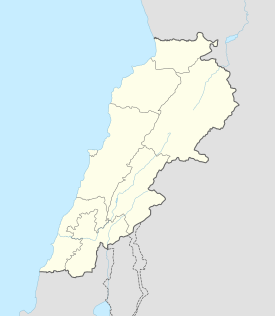Heliopolis (Syria)
|
Baalbek بعلبك |
|
|---|---|
| City | |

|
|
| Location in Lebanon | |
| Coordinates: 34°0′22.81″N 36°12′26.36″E / 34.0063361°N 36.2073222°ECoordinates: 34°0′22.81″N 36°12′26.36″E / 34.0063361°N 36.2073222°E | |
| Governorate | Baalbek-Hermel |
| District | Baalbek |
| Area | |
| • City | 7 km2 (3 sq mi) |
| • Metro | 16 km2 (6 sq mi) |
| Elevation | 1,170 m (3,840 ft) |
| Population | |
| • City | 82,608 |
| • Metro | 105,000 |
| Time zone | EET (UTC+2) |
| • Summer (DST) | +3 (UTC) |
| UNESCO World Heritage Site | |
| Criteria | Cultural: i, iv |
| Reference | 294 |
| Inscription | 1984 (8th Session) |
Baalbek (/ˈbɑːlbɛk/), properly Baʿalbek (Arabic: ) and also known as Balbec,Baalbec or Baalbeck, is a city in the Anti-Lebanon foothills east of the Litani River in Lebanon's Beqaa Valley, about 85 km (53 mi) northeast of Beirut and about 75 km (47 mi) north of Damascus. The capital of Baalbek-Hermel Governorate, Baalbek has a population of approximately 82,608, mostly Shia Muslims, followed by Sunni Muslims and a minority of Christians. It is reckoned a stronghold of the Shi'a Hezbollah movement. It is home to the annual Baalbeck International Festival.
A few miles from the swamp from which the Litani (the classical Leontes) and the Asi (the upper Orontes) flow, Baalbek may be the same as the MBK NHRM ("Source of the Two Rivers"), the abode of El in the Ugaritic Baal Cycle discovered in the 1920s and a separate serpent incantation.
...
Wikipedia

